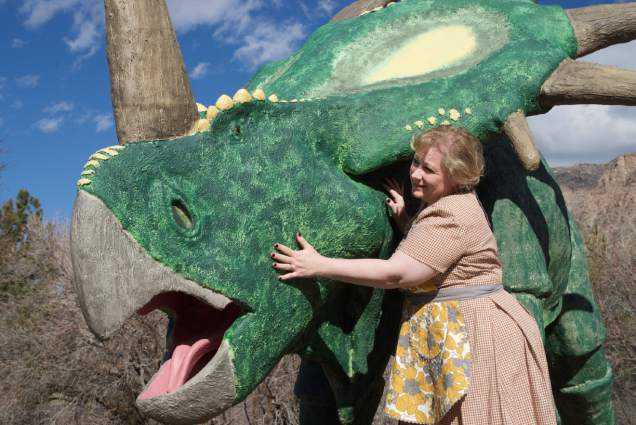SALT LAKE CITY — “We came through the depression by the skin of our teeth, that’s true!—one more tight squeeze like that and where will we be?” launches the starting point for this 1943 Pulitzer Prize winning drama by Thornton Wilder, The Skin of our Teeth. This play is non-traditional and somewhat abstract in its format, bordering on “theatre of the absurd.” The title character Sabina (played by Sarah Danielle Young) acts as a narrator reminiscent of the Stage Manager in Wilder’s Our Town as she serves as a liaison between the actors in the play and the audience. Sabina frequently reminds the audience that they are watching a play, and stops and starts the action periodically, gets in arguments with the stage crew, and refuses to do certain scenes.

The play is presented in three acts, beginning in prehistoric/biblical times, continuing through the Roaring Twenties and ending in then-current time of the 1940’s (following the Great Depression). Though the play spans thousands of years, the vernacular and period remains consistently 1940’s in acting style, hairstyles and vernacular. The Skin of Our Teeth revolves around the traditional American family living in the imaginary small town of Excelsior, New Jersey, and examines the relationship between the different family members in various time periods. Using the family as the constant in each act, Wilder shows how history repeats itself over and over again. Indeed, the play ends with Sabina directly addressing the audience and stating that, “this play has not yet finished being written” and turning over the responsibility for its continuation or completion to the audience.

The production was anchored by strong leads. Jason Tatom, who played the leading role of Mr. Antrobus, is a large man with a commanding presence and powerful voice. Tatom portrayed a kind man striving to do his best for his family, but he was lured by temptations and shortcomings throughout the play. This is examined closest in Act II, where he is entranced by Sabina (who is then playing the “younger woman”) to leave his wife. Kristin Housley brought passion and depth as Mrs. Antrobus, showing an unconditional love for her children and husband, despite their shortcomings and wrongdoings. Housley and Tatom contrasted each other nicely in their energy and interactions, making a very believable couple.

Sarah Danielle Young as Sabina kept me engaged with humor and sex in an appropriate 1940’s fashion throughout the play. She was largely the comedic relief for the show and kept the pace and energy driving through each Act. Mike T. Brown as Henry and Marcella Pereda as Gladys brought youthful energy in their respective roles, completing the believable family unit. Brown’s interactions with his stage father, especially in Act II, showed the struggling and conflicted relationship many young men face as they leave home and strive for independence. In each act more was revealed about each member of the family and how they dealt with and barely survived the current conflict, which included the ice age, a flood, and world war.
The ensemble members supported the lead actors in an appropriate fashion as they contributed to the time period and brought individual personalities and characters to each act. Whether that be portraying dinosaurs, townspeople, or troupes in the military, the cohesive ensemble delivered on just the right level. Notable performances in the ensemble included Hyrum Housely as the telegraph boy, Alyssa Franks as the eccentric fortuneteller, and Andrew Maizner as the announcer.
Director Mark Fossen utilized the space in creative ways, such as having actors appearing in the audience, in front of the proscenium, and in the side openings of the stage to create levels and incorporate the audience and actors into the world of the play. Fossen kept the focus on the themes of the story by finding the “love for humanity and an appreciation for the canvas that our existence is painted on” as he states in his director’s note, and allowing the abstract format of the production to support—rather than distract—from these themes.
The technical elements greatly enhanced the production, creating both an abstract world and a link between each act. The projections (designed by Jesse Portillo) were well crafted and began each act as World News. The set (designed by Halee Rasmussen) maintained the form of the preceding act, but was altered in an appropriate fashion for the next setting. This made the set deftly mirror the actors repeating characters in each act but in different settings. Plus it visually represented the family members falling apart by the end of the play.
I would recommend The Skin of our Teeth to the astute theater goer. Its unconventional form and dated writing have not always aged well, and younger audiences and casual theatergoers may become disengaged with the material with its nonlinear storyline, which can be confusing. However, those looking for a unique and well-performed production of this rarely done piece, should not miss out on this opportunity to see one of the great American classics.
[box type=”shadow”]The Skin of Our Teeth plays Thursdays through Saturdays at the Grand Theatre (1575 S. State Street, Salt Lake City) through March 28 at 7:30 PM and on Saturdays at 2 PM. Tickets are $14-$20. For more information, visit www.the-grand.org.[/box]
